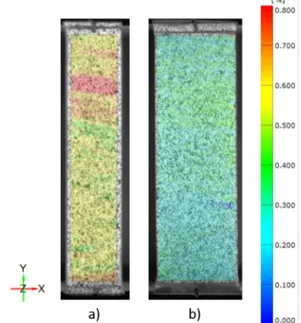44
ISBN: 978-91-88898-64-7
In-plane Elastic Behavior of Transparent Wood Composite Measured with Digital
Image Correlation
Erik Jungstedt†*, Lars Berglund†, and Sören Östlund‡
† KTH Royal Institute of Technology, Department of Fibre and Polymer Technology, 100 44 Stockholm Sweden,
erikjun@kth.se, blund@kth.se
‡KTH Royal Institute of Technology, Department of Solid Mechanics, 100 44 Stockholm Sweden, soren@kth.se Wood has been used as a load-bearing material in applications such as buildings and constructions for years, due to its renewable nature, easy manufacturing ability and excellent mechanical performance. The advancement of nanotechnology enables modifications within the wood hierarchical structure such as lumen and cell wall, providing new possible functionalities when impregnated in a poly methyl methacrylate (PMMA) matrix. Particularly, the concept of transparent wood composite stands out since it has interesting optical properties while preserving the load bearing capacity and microstructure that wood naturally has [1]. The reinforcement effects from a delignified, nanoporous wood template are unknown, and are compared with native wood veneer as the reinforcement. It has earlier been shown that transparent wood composites are possible to laminate for desired mechanical performance, which expands the usability for the material as it can be customized for applications [2]. However, characterization of the in-plane elastic parameters from a single ply is then a necessity as they form the basis of lamination theory of orthotropic materials. Within this work the interest is to determine the four elastic parameters. The in-plane strain field is also investigated in detail during deformation, and reinforcement effects are analysed. To resolve the matters a set of tensile experiments were done and a non-contact deformation measurement technique (digital image correlation) was used to capture the strain fields during quasi-static loading. The focus has been on small strip samples from veneers with material axes along the woods tangential (T) and longitudinal (L) axes.
Figure 1: Strain field at average Strain 0.002 in vertical Y-axis along the tangential material axis of a) Native Wood and b) transparent wood composite.
References
[1] Y. Li, Q. Fu, S. Yu, L. Berglund, Optically Transparent Wood from a Nanoporous Cellulosic Template: Combining Functional and Structural Performance, Biomacromolecules. 17 (2016) 1358-1364.
[2] Q. Fu, M. Yan, E. Jungstedt, X. Yang, Y. Li, L.A. Berglund, Transparent plywood as a load-bearing and luminescent biocomposite, Compos. Sci. Technol. 164 (2018) 296-303.
